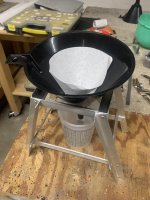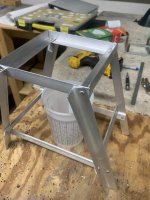Just sharing a small but satisfying project I completed yesterday.
I jumped on the K&P reusable oil filter bandwagon this year, given the skyrocketing prices of the normal spin-on filters. However, I hadn't broken the code on how to catch and inspect the contaminants from the filter element since the filter's not meant for disassembly. So I built a funnel scaffold. That's what I'm calling it...a funnel scaffold, because I built it. I get to name it.
With some 3/4 x 3/4 aluminum angle and bar from Home Depot Aviation Supply, I crafted this framework that stands over a fluid catch cup and holds a large funnel. Insert a coffee filter, then go to town blasting the oil filter element with brake cleaner. The cleaner and oil filter detritus collect in the coffee filter. Inspect and toss that, then clean and reuse the oil filter element. Easy peasy.
I jumped on the K&P reusable oil filter bandwagon this year, given the skyrocketing prices of the normal spin-on filters. However, I hadn't broken the code on how to catch and inspect the contaminants from the filter element since the filter's not meant for disassembly. So I built a funnel scaffold. That's what I'm calling it...a funnel scaffold, because I built it. I get to name it.
With some 3/4 x 3/4 aluminum angle and bar from Home Depot Aviation Supply, I crafted this framework that stands over a fluid catch cup and holds a large funnel. Insert a coffee filter, then go to town blasting the oil filter element with brake cleaner. The cleaner and oil filter detritus collect in the coffee filter. Inspect and toss that, then clean and reuse the oil filter element. Easy peasy.
Attachments
Last edited:






